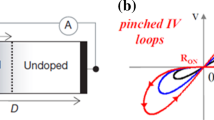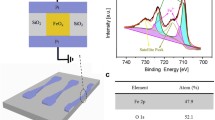Abstract
Nowadays, memristors are extremely similar to biological synapses and can achieve many basic functions of biological synapses, making them become a new generation of research hotspots for brain-like neurocomputing. In this work, we prepare a memristor based on two-dimensional α-In2Se3 nanosheets, which exhibits excellent electrical properties, faster switching speeds, and continuous tunability of device conduction. Meanwhile, most basic bio-synapse functions can be implemented faithfully, such as short-term memory (STM), long-term memory (LTM), four different types of spike-timing-dependent plasticity (STDP), and paired-pulse facilitation (PPF). More importantly, we systematically study three effective methods to achieve LTM, in which the reinforcement learning can be faithfully simulated according to the Ebbinghaus forgetting curve. Therefore, we believe this work will promote the development of learning functions for brain-like computing and artificial intelligence.

摘要
忆阻器与生物突触极为相似, 可以实现生物突触的基本功能, 使其成为了新一代类脑神经计算的研究热点. 在这项工作中, 我们制造了基于二维α-In2Se3材料的忆阻器件, 其表现出了优异的电学性能、 较快的开关速度(16.4和18.0 ns)以及器件电导的连续可调性. 同时, 大多数基本的生物突触功能得以实现, 如短时记忆(STM)、 长时记忆(LTM)、 四种不同类型的尖峰时间依赖可塑性(STDP)和双脉冲易化行为(PPF). 更重要的是, 我们系统性地研究了三种实现长时记忆的有效方法, 其中, 根据艾宾浩斯遗忘曲线成功地模拟了强化学习功能. 这项工作将促进类脑神经计算以及人工智能在学习方面的研究发展.
Similar content being viewed by others
References
Yao P, Wu H, Gao B, et al. Fully hardware-implemented memristor convolutional neural network. Nature, 2020, 577: 641ȓ646
Joksas D, Freitas P, Chai Z, et al. Committee machinesȔA universal method to deal with non-idealities in memristor-based neural networks. Nat Commun, 2020, 11: 1
Yan X, Pei Y, Chen H, et al. Self-assembled networked PbS distribution quantum dots for resistive switching and artificial synapse performance boost of memristors. Adv Mater, 2019, 31: 1805284
Tang J, Yuan F, Shen X, et al. Bridging biological and artificial neural networks with emerging neuromorphic devices: Fundamentals, progress, and challenges. Adv Mater, 2019, 31: 1902761
Fu T, Liu X, Gao H, et al. Bioinspired bio-voltage memristors. NatCommun, 2020, 11: 1861
Yang JT, Ge C, Du JY, et al. Artificial synapses emulated by an electrolyte-gated tungsten-oxide transistor. Adv Mater, 2018, 30: 1801548
Lan J, Cao G, Wang J, et al. Artificial nociceptor based on TiO2 na-nosheet memristor. Sci China Mater, 2021, 64: 1703–1712
Prezioso M, Merrikh-Bayat F, Hoskins BD, et al. Training and operation of an integrated neuromorphic network based on metal-oxide memristors. Nature, 2015, 521: 61–64
Sun K, Chen J, Yan X. The future of memristors: Materials engineering and neural networks. Adv Funct Mater, 2021, 31: 2006773
Wang H, Yu T, Zhao J, et al. Low-power memristors based on layered 2D SnSe/graphene materials. Sci China Mater, 2021, 64: 1989–1996
Wang Z, Joshi S, Savel’ev SE, et al. Memristors with diffusive dynamics as synaptic emulators for neuromorphic computing. Nat Mater, 2017, 16: 101–108
Milano G, Luebben M, Ma Z, et al. Self-limited single nanowire systems combining all-in-one memristive and neuromorphic functionalities. Nat Commun, 2018, 9: 1
Fiori G, Bonaccorso F, Iannaccone G, et al. Electronics based on two-dimensional materials. Nat Nanotech, 2014, 9: 768–779
Liu C, Chen H, Wang S, et al. Two-dimensional materials for next-generation computing technologies. Nat Nanotechnol, 2020, 15: 545–557
Bae SH, Kum H, Kong W, et al. Integration of bulk materials with two-dimensional materials for physical coupling and applications. NatMater, 2019, 18: 550–560
Fan Q, Wang L, Xu D, et al. Solution-gated transistors of two-dimensional materials for chemical and biological sensors: Status and challenges. Nanoscale, 2020, 12: 11364–11394
Rojaee R, Shahbazian-Yassar R. Two-dimensional materials to address the lithium battery challenges. ACS Nano, 2020, 14: 2628–2658
Chia X, Pumera M. Characteristics and performance of two-dimensional materials for electrocatalysis. Nat Catal, 2018, 1: 909–921
Wang S, Liu L, Gan L, et al. Two-dimensional ferroelectric channel transistors integrating ultra-fast memory and neural computing. NatCommun, 2021, 12: 53
Zhang Z, Wang Z, Shi T, et al. Memory materials and devices: From concept to application. InfoMat, 2020, 2: 261–290
Wang B, Sun Y, Ding H, et al. Bioelectronics-related 2D materials beyond graphene: Fundamentals, properties, and applications. Adv Funct Mater, 2020, 30: 2003732
Yan X, Zhang L, Yang Y, et al. Highly improved performance in Zr0.5Hf0.5O2 films inserted with graphene oxide quantum dots layer for resistive switching non-volatile memory. J Mater Chem C, 2017, 5: 11046–11052
Huh W, Lee D, Lee CH Memristors based on 2D materials as an artificial synapse for neuromorphic electronics Adv Mater, 2020, 32: 2002092
Zhao Q, Xie Z, Peng YP, et al. Current status and prospects of mem-ristors based on novel 2D materials Mater Horiz, 2020, 7: 1495–1518
Schranghamer TF, Oberoi A, Das S Graphene memristive synapses for high precision neuromorphic computing Nat Commun, 2020, 11: 5474
Chen S, Mahmoodi MR, Shi Y, et al. Wafer-scale integration of two-dimensional materials in high-density memristive crossbar arrays for artificial neural networks Nat Electron, 2020, 3: 638–645
Yan X, Zhao Q, Chen AP, et al. Vacancy-induced synaptic behavior in 2D WS2 nanosheet-based memristor for low-power neuromorphic computing. Small, 2019, 15: 1901423
Zhu X, Li D, Liang X, et al. Ionic modulation and ionic coupling effects in MoS2 devices for neuromorphic computing. Nat Mater, 2019, 18: 141–148
Shi H, Li M, Shaygan Nia A, et al. Ultrafast electrochemical synthesis of defect-free In2Se3 flakes for large-area optoelectronics. Adv Mater, 2020, 32: 1907244
Zhao Y, Cai Y, Zhang L, et al. Thermal transport in 2D semiconductors —Considerations for device applications. Adv Funct Mater, 2020, 30: 1903929
Sun H, Liu Q, Li C, et al. Direct observation of conversion between threshold switching and memory switching induced by conductive filament morphology. Adv Funct Mater, 2014, 24: 5679–5686
Yan X, Zhao J, Liu S, et al. Memristor with Ag-cluster-doped TiO2 films as artificial synapse for neuroinspired computing. Adv Funct Mater, 2018, 28: 1705320
Wang K, Li L, Zhao R, et al. A pure 2H-MoS2 nanosheet-based memristor with low power consumption and linear multilevel storage for artificial synapse emulator. Adv Electron Mater, 2020, 6: 1901342
Yan X, Zhang L, Chen H, et al. Graphene oxide quantum dots based memristors with progressive conduction tuning for artificial synaptic learning. Adv Funct Mater, 2018, 28: 1803728
Xing G, Li Y, Fan X, et al. Sn2Se3: A conducting crystalline mixed valent phase change memory compound. J Appl Phys, 2017, 121: 225106
Zhang J, Yang T, Wang J, et al. Memristive device with highly continuous conduction modulation and its underlying physical mechanism for electronic synapse application. Sci China Mater, 2021, 64: 179–188
Pei Y, Zhou Z, Chen AP, et al. A carbon-based memristor design for associative learning activities and neuromorphic computing. Nanoscale, 2020, 12: 13531–13539
Hahnloser RHR, Sarpeshkar R, Mahowald MA, et al. Digital selection and analogue amplification coexist in a cortex-inspired silicon circuit. Nature, 2000, 405: 947–951
Tao J, Sarkar D, Kale S, et al. Engineering complex synaptic behaviors in a single device: Emulating consolidation of short-term memory to long-term memory in artificial synapses via dielectric band engineering. Nano Lett, 2020, 20: 7793–7801
Wang Z, Zeng T, Ren Y, et al. Toward a generalized Bienenstock-Cooper-Munro rule for spatiotemporal learning via triplet-STDP in memristive devices. Nat Commun, 2020, 11: 1510
Yan X, Wang K, Zhao J, et al. A new memristor with 2D Ti3C2Tx MXene flakes as an artificial bio-synapse. Small, 2019, 15: 1900107
Cao Y, Rushforth AW, Sheng Y, et al. Tuning a binary ferromagnet into a multistate synapse with spin-orbit-torque-induced plasticity. Adv Funct Mater, 2019, 29: 1808104
Yan X, Zhou Z, Zhao J, et al. Flexible memristors as electronic synapses for neuro-inspired computation based on scotch tape-exfoliated mica substrates. Nano Res, 2018, 11: 1183–1192
Bannur B, Kulkarni GU. On synapse intelligence emulated in a self-formed artificial synaptic network. Mater Horiz, 2020, 7: 2970–2977
Chabi D, Wang Z, Bennett C, et al. Ultrahigh density memristor neural crossbar for on-chip supervised learning. IEEE Trans Nanotechnol, 2015, 14: 954–962
Hu SG, Liu Y, Chen TP, et al. Emulating the Ebbinghaus forgetting curve of the human brain with a NiO-based memristor. Appl Phys Lett, 2013, 103: 133701
Acknowledgements
This work was financially supported by the National Key R&D Plan “Nano Frontier” Key Special Project (2021YFA1200502), the Cultivation Projects of National Major R&D Project (92164109), the National Natural Science Foundation of China (61874158, 62004056 and 62104058), the Special Project of Strategic Leading Science and Technology of Chinese Academy of Sciences (XDB44000000-7), Hebei Basic Research Special Key Project (F2021201045), the Support Program for the Top Young Talents of Hebei Province (70280011807), the Supporting Plan for 100 Excellent Innovative Talents in Colleges and Universities of Hebei Province (SLRC2019018), the Outstanding Young Scientific Research and Innovation Team of Hebei University (605020521001), the Special Support Funds for National High Level Talents (041500120001), the High-level Talent Research Startup Project of Hebei University (521000981426), the Science and Technology Project of Hebei Education Department (QN2020178 and QN2021026), and the Post-graduate’s Innovation Fund Project of Hebei Province (CXZZBS2022020).
Author information
Authors and Affiliations
Contributions
Author contributions Yan X proposed the idea, integrated interpretation and revised the paper. Zhao Y completed the performance test of the device and drafted the manuscript. Pei Y fabricated the device and assisted in writing the manuscript. Zhang Z revised the paper. Li X, Wang J, Yan L and He H helped with characterization analysis. Zhou Z, Zhao J, and Chen J coordinated the work. All authors commented on the final paper.
Corresponding author
Ethics declarations
Conflict of interest The authors declare that they have no conflict of interest.
Additional information
Supplementary information Details of the simulation and supporting data are available in the online version of this paper.
Ying Zhao received her BSc degree in applied electronic technology education from the School of Physics and Electronic Science, Hunan University of Science and Technology in 2019. She is currently an ME student of Hebei University. Her current research focuses on the field of memristors.
Yifei Pei received the MS degree from Hebei University, Baoding, China, in 2020. She is currently pursuing a PhD degree at the Department of Physics at Hebei University, Baoding, China. Her current research focuses on the field of memristors.
Xiaobing Yan is currently a professor at the School of Electronic and Information Engineering, Hebei University. He received his PhD degree from Nanjing University in 2011. From 2014 to 2016, he held the research fellow position at the National University of Singapore. His current research focuses on the field of memristors.
Supplementary Information
Rights and permissions
About this article
Cite this article
Zhao, Y., Pei, Y., Zhang, Z. et al. Memristor based on α-In2Se3 for emulating biological synaptic plasticity and learning behavior. Sci. China Mater. 65, 1631–1638 (2022). https://doi.org/10.1007/s40843-021-1925-x
Received:
Accepted:
Published:
Issue Date:
DOI: https://doi.org/10.1007/s40843-021-1925-x




